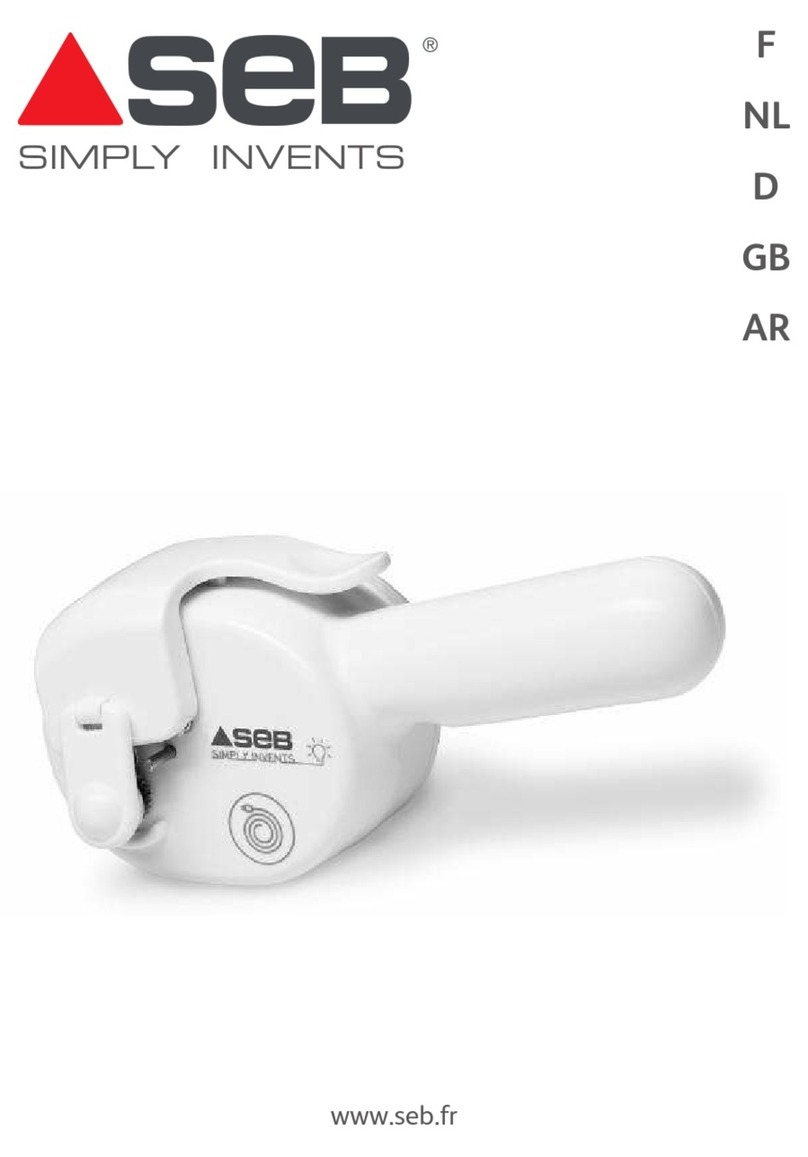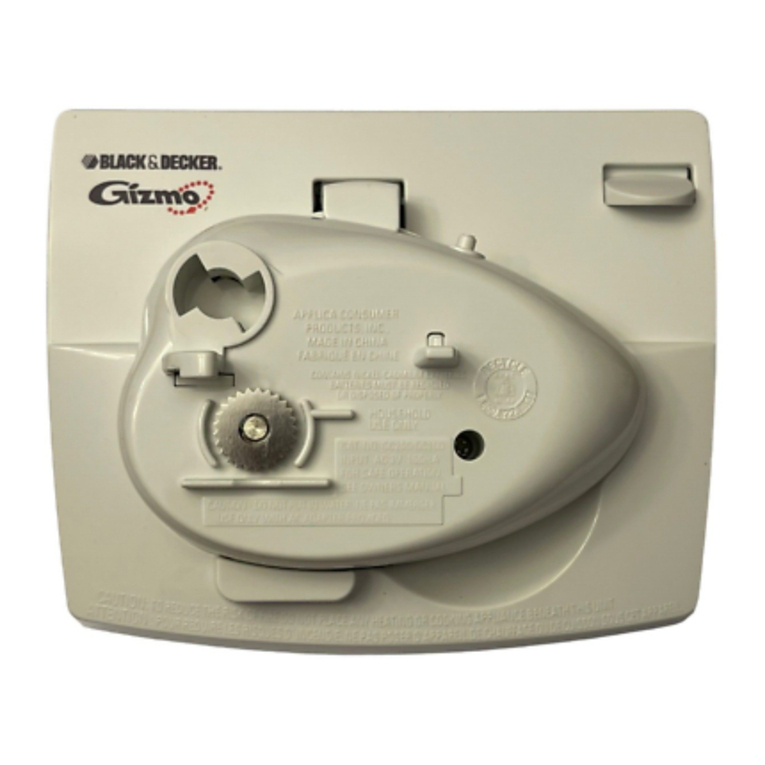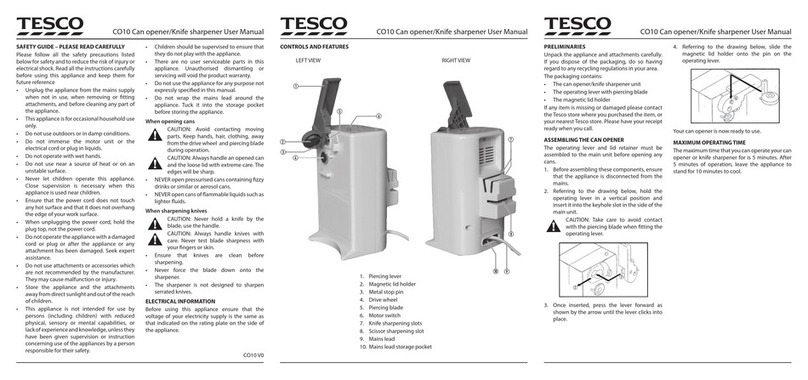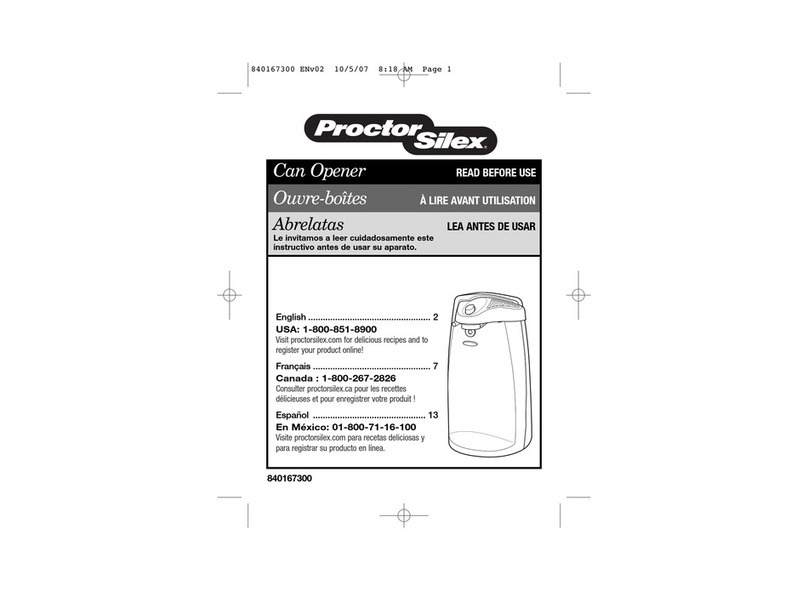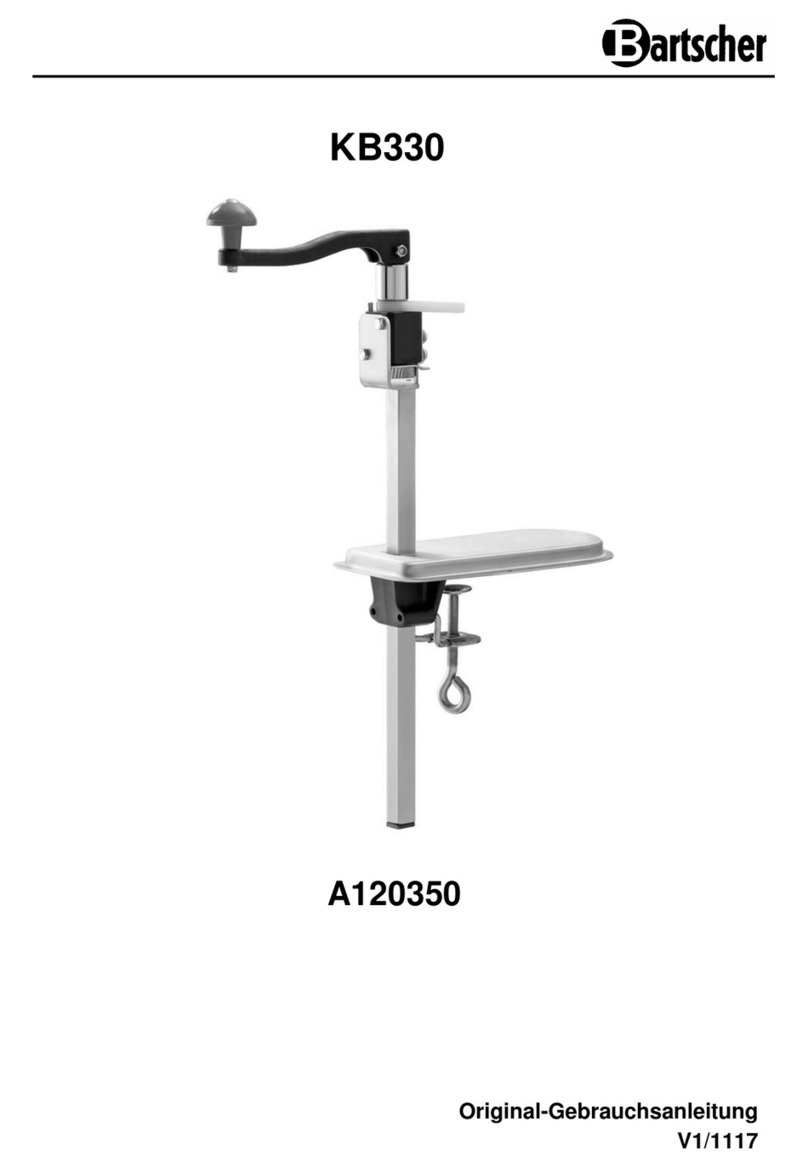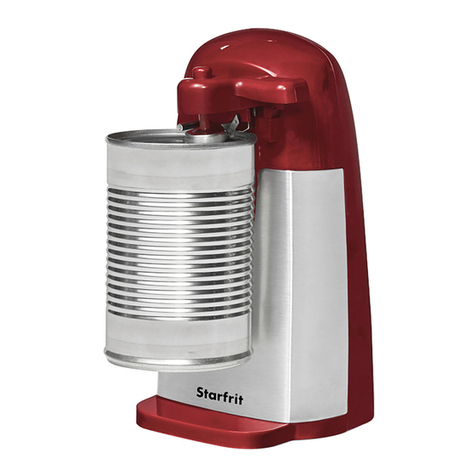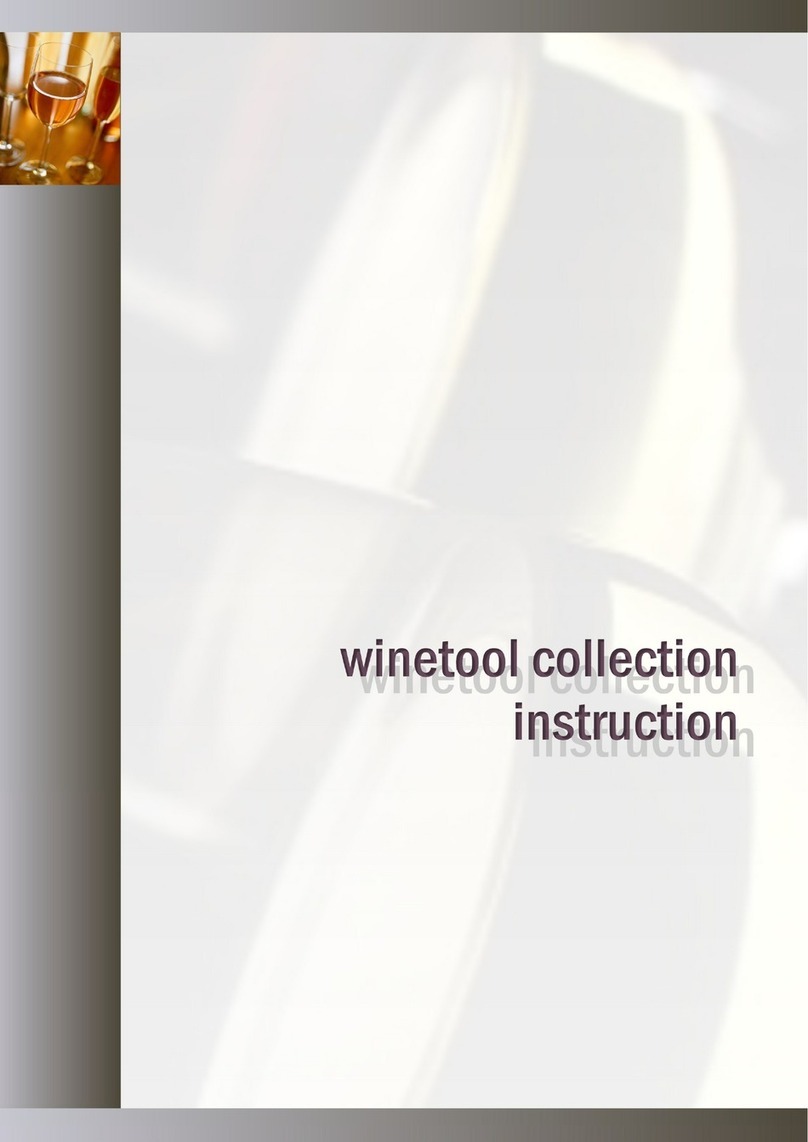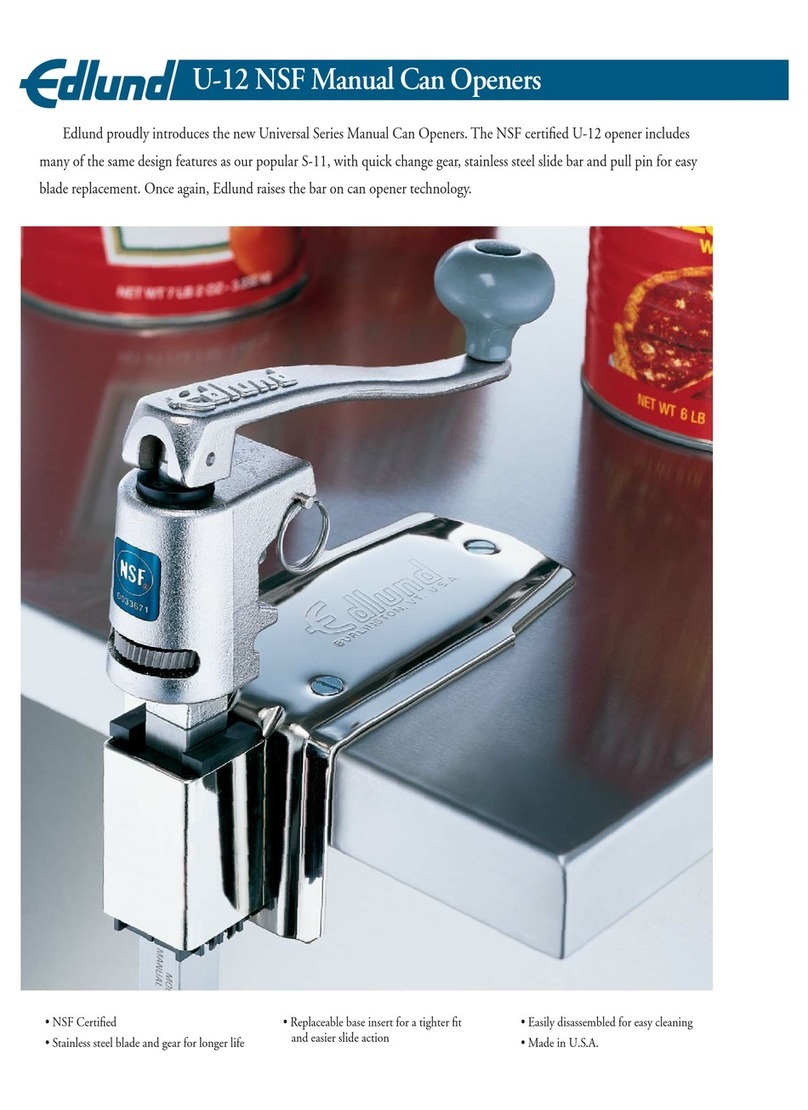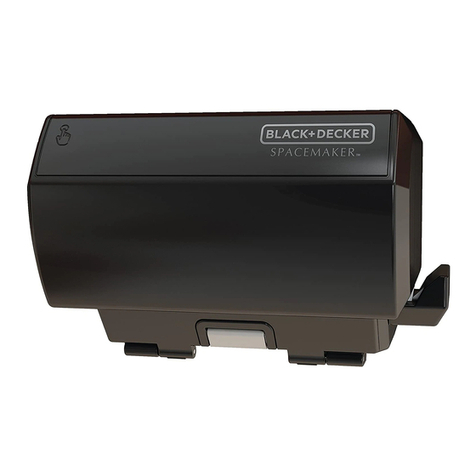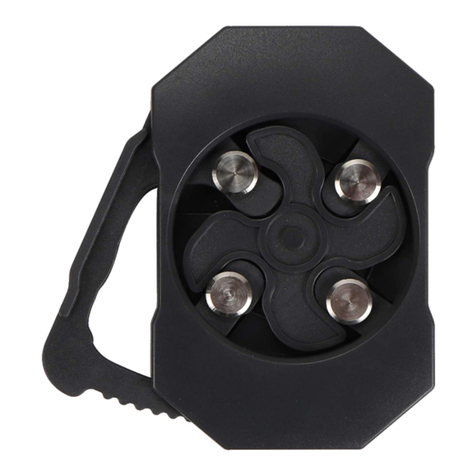Sky Master AL User manual

44203.8-JULHO/2011
Instruction Manual
CAN OPENER
MODEL: AL
- ALÉM DESTAS MÁQUINAS, FABRICAMOS UMA LINHA COMPLETA DE EQUIPAMENTOS. CONSULTE SEU REVENDEDOR.
- ESTE PRODUTO CONTA COM ASSISTÊNCIA TÉCNICA, REPRESENTANTES E REVENDEDORES EM TODO TERRITÓRIO NACIONAL.
DEVIDO À CONSTANTE EVOLUÇÃO DOS NOSSOS PRODUTOS, AS INFORMAÇÕES AQUI CONTIDAS PODEM SER MODIFICADAS SEM AVISO PRÉVIO.
LINHA DIRETA
SKYMSEN
Ramai s 2 011
2012
2013
E-mail: [email protected]
METALÚRGICA SIEMSEN LTDA.
Rua Anita Garibaldi, nº 262 – Bairro: Sno Luiz – CEP: 88351-410
Brusque – Santa Catarina – Brasil
Fone: +55 47 3211 6000 / 3255 2000
Fax: +55 47 3211 6020 / 3255 2020

09
5. Analysis and Problem Solutions
5.1 Problems Causes and Solutions
The Can Opener Model AL were designed to operate with the need
of minimum maintenance but the natural wearing caused by long use of the
equipment may occasionally cause some malfunctions.
If such problem occurs with your processor refer to Table 02 in
which the most common situations are listed with recommended
solutions.
Table - 02
Problem Cause Solutions
* Blunt knife. * C a l l T e c h n i c a l
Assistance.
* The Can Opener do not
open the cans.

01
08
1.2 Main Components
1.3 Technical Characteristcs
1. Introduction
02
1.1 Safety
02
02
03
2. Installation
2.1 Installation
03
03
4. General Safety Practices
4.1 Basic Operation Procedures
4.4 Operation
4.2 Safety Procedures and Notes Before Switching the Machine On
4.5 After Finishing the Work
4.3 Routine Inspection
4.6 Maintenance
4.7 Advices
06
06
07
08
08
08
08
08
5. Analysis and Problem Solving
5.1 Problems, Causes e Solutions
09
09
3. Operation
3.1 Starting
3.2 Cleaning
04
04
05
SUMMARY
4.3 Routine Inspection
4.3.1 Advice
When checking the tension of the belts or chains, DO NOT introduce your
fingers between the belts and the pulleys and nor between the chain and the gears.
4.3.2 Precautions
Check if motors and sliding or turning parts of the machine produce abnormal
noises.
Check the tension of the belts and chains and replace the set when belt or
chain show signs of being worn out.
When checking tensions of belts or chain DO NOT introduce your fingers
between belts and pulleys, nor between the chains and gears.
Check protections and safety devices to make sure they are working properly.
4.4 Operation
4.4.1 Advice
Be sure your hair is not loose in order to avoid getting caught by turning parts
which could lead to a serious accident. Tie your hair well up and/or cover your head with
a scarf.
The operation performed by not trained or skilled personnel shall be forbidden.
Never touch turning parts with your hands or in any other way.
NEVER operate machine without all original safety devices under perfect conditions.
4.5 After Finishing The Work
4.5.1 Precautions
Always TURN THE MACHINE OFF by removing the plug from the socket before
cleaning the machine.
Never clean the machine unless it has come to a COMPLETE STOP.
Put all components back to their functional positions before turning it ON again. DO
NOT place your fingers in between belts and pulleys nor chains and gears.
4.6 Maintenance
4.6.1 Danger
Any maintenance with the machine in working situation is dangerous. TURN IT
OFF BY PULLING THE PLUG OFF THE SOCKET DURING MAINTENANCE.
IMPORTANT
Always unplug the machine when emergency cases arise.
4.7 Advice
Electrical or mechanical maintenance must be done by qualified personal for
such operation.
Person in charge has to be sure that the machine is under TOTAL SAFETY
conditions when working.

02
1 Introduction
1.1 Safety
The Can Opener is simple to use and to clean, however read
the below instructions to be followed in order to avoid
accidents :
1.1.1 Never use instruments not belonging to it in order to
help operation .
1.1.2 Never spray water directly on the equipment
1.1.3 Never introduce the hands into sharp places of the
opener .
1.2 Main Components
All the components of the equipment have been made of raw
materials carefully selected for each function .
Picture 01
01 . Handle
02 . Knife
03 . Shaft
04 . Base
01
03
02
04
07
Water or oil spilled on the floor will turn it slippery and dangerous. Make sure the floor
is clean and dry.
Before giving any manual command (switch, buttons, turn keys or lever) be
sure the command is the correct one. Check this manual for further details if
necessary.
Never use a manual command (switch, buttons, lever) unadvisedly.
If any work is to be made by two or more persons, coordination signs will have to be
given for each operation step. Every step of the operation shall be taken only if the
sign has been made and responded.
4.1.3 Advices
In case of power shortage, immediately turn the machine OFF.
Use recommended or equivalent lubricants, oils or greases.
Avoid mechanical shocks as they may cause failures or malfunction.
Avoid penetration of water, dirt or dust into mechanical or electrical
components of the machine.
DO NOT MODIFY original characteristics of the machine.
DO NOT REMOVE, TEAR OFF or MACULATE ANY SAFETY or IDENTIFICATION
LABELS stuck on the machine. If any label has been removed or is no longer legible,
contact your nearest dealer for replacement.
4.2 Safety Procedures and Notes Before Switching Machine ON
IMPORTANT
Carefully read ALL INSTRUCTIONS of this manual before turning the machine
ON. Be sure to be familiar with the instructions and that you have well
understood all information contained in this manual. If you have any question
contact your supervisor or your nearest Dealer.
4.2.1 Danger
An electric cable or electric wire with damaged jacket or bad insulation could
cause electrical shocks as well as electrical leak. Before use, check conditions of all
wires and cables.
4.2.2 Advices
Be sure ALL INSTRUCTIONS in this manual have been thoroughly
understood. Every function and operational procedure have to be very clear to the
operator. Contact your nearest Dealer for further questions.
Any manual command (switch, button or lever) shall be given only after being
sure it is the correct one.
4.2.3 Precautions
The electric cable has to be compatible with the power required by the
machine. Cables touching the floor or close to the machine need to be protected
against short circuits.

03
1.3 Technical Characteristics
Table - 01
Characteristics
Unit
AL
500
240
230
3,3
Height
Width
Depth
Net Weight
Gross Weight
Maximum Working height
[mm]
[mm]
[mm]
[kg]
[kg]
[mm]
3,7
270
2.1 Installation
The Can Opener installation is made by means of
the three screws coming along with the equipment. Just screw
the equipment Base # 04 (Pict. 01) upon a stable surface ,
having preferably 850 mm height above floor
Picture - 02
2. Installation
850mm
130mm
50mm
Measures to fix the Base
06
4. General Safety Practices
The following safety instructions are addressed to both the operator of the
machine as well as the person in charge of maintenance. The machine has to be
delivered to the operator in perfect conditions of use by the Distributor to the user. The
user shall operate the machine only after being well acquainted with the safety
procedures described in the present manual. READ THIS MANUAL WITH ATTENTION.
4.1 Basic Operation Practices
4.1.1 Dangerous parts
Some parts of the electric devices are connected to high voltage points. These
parts when touched may cause severe electrical shocks or even be FATAL.
Never touch commands such as buttons, switches and knobs with wet hands,
wet clothes and/or shoes. By not following these instructions operator could be exposed
to severe electrical shocks or even to a FATAL situation.
4.1.2 Warnings
The operator has to be well familiar with the position of ON/OFF Switch to make
sure the Switch is easy to be reached when necessary. Before any kind of maintenance,
physically remove plug from the socket.
Provide space for a comfortable operation thus avoiding accidents.
IMPORTANT
If any item from the GENERAL SAFETY NOTIONS section is not
applicable to your product, please disregard it.

04 05
This equipment has been designed for easy cleaning. To
Clean h the Can Opener use a damp cloth.
3.2 Cleaning
3 Operation
3.1 Usage
Having installed the Can Opener , lift the Handle # 01 (Pic.03),
then lift the Shaft # 03 (Pic.01) and the Handle high enough, and introduce
the can as it might be seen on picture 03 . Using the Handle lower with
force the Shaft in order to make a first cut on the can lid. Lower the
Handle to its normal position and turn it until the lid is completely cut, see
picture 04. Lift the Handle and remove the can . see picture 05 .
Picture - 03
Picture - 05
Picture - 04
01
3.2.1- Cautions with Stainless Steel
The Stainless Steel may present rust signs, which ARE ALWAYS
CAUSED BY EXTERNAL AGENTS, especially when the cleaning or
sanitization is not constant and appropriate.
The Stainless Steel resistance towards corrosion is mainly due to the
presence of chrome, which in contact with oxygen allows the formation of a very
thin protective coat. This protective coat is formed through the whole surface of
the steel, blocking the action of external corrosive agents.
When the protective coat is broken, the corrosion process begins, being
possible to avoid it by means of constant and adequate cleaning.
Cleaning must always be done immediately after using the equipment.
For such end, use water, neutral soap or detergent, and clean the equipment with a
soft cloth or a nylon sponge. Then rinse it with plain running water, and dry
immediately with a soft cloth, this way avoiding humidity on surfaces and
especially on gaps.
The rinsing and drying processes are extremely important to prevent
stains and corrosion from arising.
IMPORTANT
Acid solutions, saltern solutions, disinfectants and some sterilizing
solutions ( s, tetravalent ammonia salts, iodine compounds,
nitric acid and others), must be AVOIDED, once they cannot remain
for long in contact with the stainless steel:
hypochlorite
These substances attack the stainless steel due to the CHLORINE on its
composition, causing corrosion spots (pitting).
Even detergents used in domestic cleaning must not remain in contact
with the stainless steel longer than the necessary, being mandatory to remove it
with plain water and then dry the surface completely.
Use of abrasives:
Sponges or steel wool and carbon steel brushes, besides scratching the
surface and compromising the stainless steel protection, leave particles that rust
and react contaminating the stainless steel. That is why such products must not be
used for cleaning and sanitization. Scrapings made with sharp instruments or
similar must also be avoided.
Main substances that cause stainless steel corrosion:
Dust, grease, acid solutions such as vinegar, fruit juices, etc., saltern
solutions (brine), blood, detergents (except for the neutral ones), common steel
particles, residue of sponges or common steel wool, and also other abrasives.
Table of contents
Popular Can Opener manuals by other brands
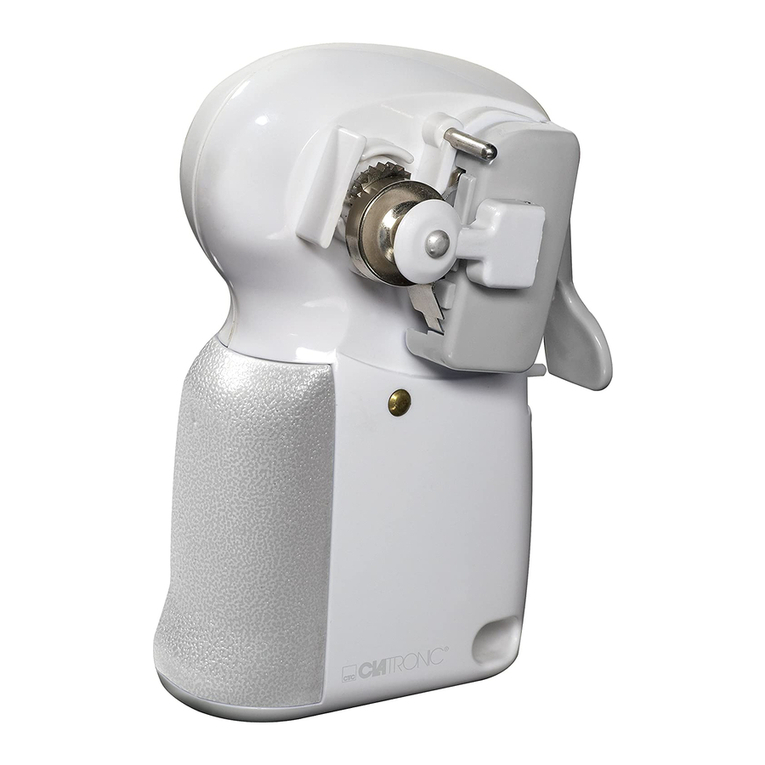
Clatronic
Clatronic DO 3204 Instruction manual & guarantee
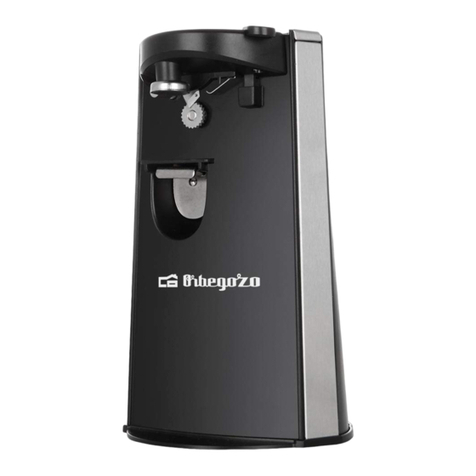
Orbegozo
Orbegozo CU 6500 instruction manual
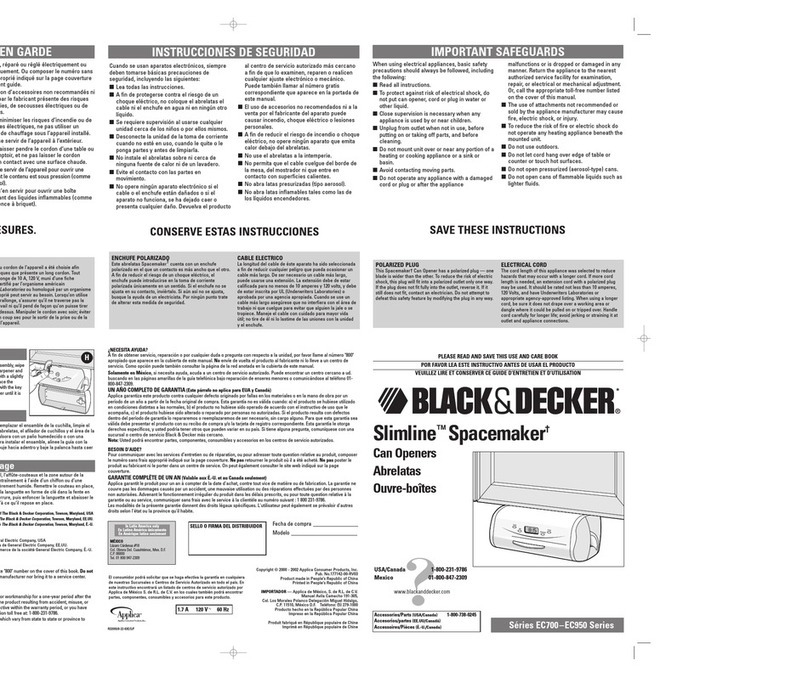
Black & Decker
Black & Decker Slimline EC700 Use and care book
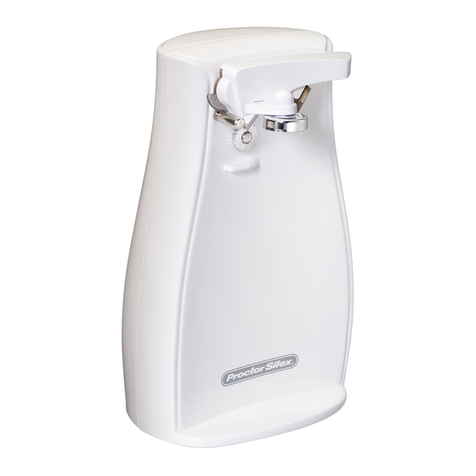
Proctor-Silex
Proctor-Silex 75224-MX use & care
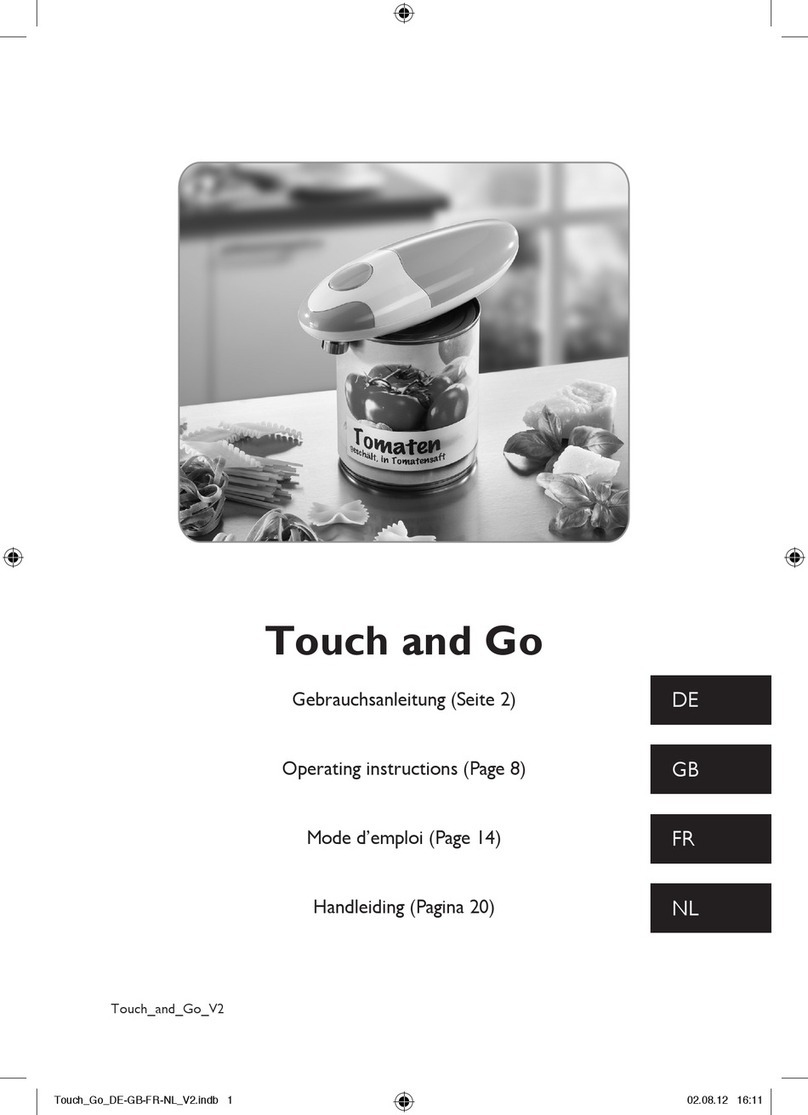
DS Produkte
DS Produkte Touch and Go SI-0301E operating instructions

Black & Decker
Black & Decker ergo KEC500 Series Use and care book
